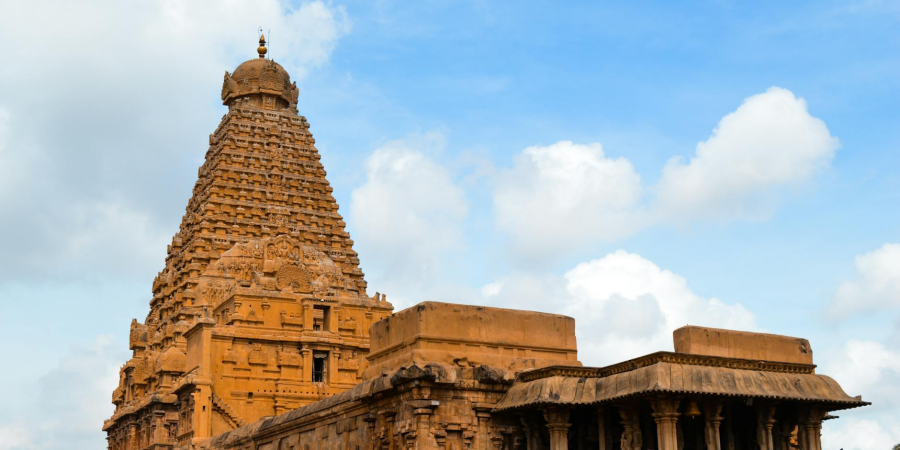

Visitors are amazed that the temple doesn't throw a shadow on the ground despite its enormous height. The clever placement of the stones in the temple's structure, which keeps a distinct shadow from forming, is credited with creating this optical illusion.
Claims that an ordinary Shiva temple in a tiny Tamil Nadu village is the last resting place of the powerful Chola emperor Raja Raja have put the temple in the public eye.
The Kailasanathar temple is located in Udaiyalur village, Thanjavur district, Tamil Nadu, and is accessible via a little path. Little sets this Shiva temple apart from the many others in this region of the nation from the outside: idols of several Hindu pantheon deities adorn the entrance arch, and prayers are offered inside to a Shiva lingam, a phallic representation of the deity, and an idol of his consort, Shakti. This temple might be special, capable of solving a centuries-old enigma, if a historian is to be believed.
This school of thinking suggests that this location could be the last resting place of none other than the legendary Chola emperor Raja Raja. It makes the case that the Tamil emperor's tomb from the eleventh century may have been covered by the Kailasanathar temple at Udaiyalur, based on historical evidence, inscriptions, iconography, and established building techniques.
Although it is known that Raja Raja Chola, whose empire encompassed portions of North India, Sri Lanka, the Maldives, and East Asia in addition to South India, passed away naturally at the age of 67, the location of his final resting place has long been a matter of speculation. There have been recent allegations that the tomb is located in Udaiyalur at a location known as Ottathoppu.
Nonetheless, renowned temple architecture expert and Chola history expert Professor G Deivanayagam is certain that the Kailasanathar temple is the right one. The founding professor of Tamil University's architecture department in Thanjavur supports his assertion with a number of hints.
Worship of ancestors:
Many religions around the nation have a ritual of erecting a memorial stone on the sixteenth day following a death, according to Deivanayagam. Usually, bereaved ladies weep, prayers are offered for the deceased, and promises to do good are made during the ritual that takes place at the stone. For individuals with little means, the memorial might be no more than a regular stone, but for the wealthy, it might be considerably more ornate and definitely grandiose for a deceased king. The memorial stone, rich in inscriptions, becomes a focal point for the king's subjects to congregate and participate in elaborate mourning.
Every day prayers are offered to the memorial stone, which is set on a pedestal and always faces east, honoring a deceased emperor who was revered as a nobleman during his lifetime.
A pandal, or protective overhead shade, is typically included on memorial stones. In the case of a king's memorial, this could be a beautiful granite pavilion or mandapa that occasionally resembles the towering vimanas (spires) of Shiva temples.
In actuality, it was during Raja Raja Chola's rule that the custom of comparing ancestors to god through the construction of memorials and prayers to them gained popularity. Aditya Chola, his great-grandfather, passed away at a young age in the area of Srikalahasti (in modern-day Andhra Pradesh). He was revered as a Shiva lingam and had a memorial constructed for him by Raja Raja Chola. He bears the name Adityeswara, the temple.
The number of these memorials increased, and they became known as pallipadai, or sepulchral temples. The Arinjigai Iswaram temple is the one that Raja Raja Chola erected in Melpadi, close to Vellore, for his other ancestor, Arinjeya Chola. These temples are identified as Pallipadai temples by inscriptions found on their walls.
Eight years prior to his demise, Raja Raja Chola is said to have converted to the Lakulisa Pasupata religion and taken up this type of ancestor worship. From Gujarat, this school of Shiva worship moved to Tamil Nadu after the seventh century.
It is also claimed that in 1010 AD, Raja Raja Chola invited four aghori gurus from Kashi (Varanasi), a Shiva-worshipping sect renowned for its severe rites, to help build the Brihadeeswara or Big Temple at Thanjavur.
Is it strange that Rajendra, the son of Raja Raja, built a Shiva temple over his father's tomb and dedicated temples to his predecessors, whom he revered as gods? Deivanayagam enquires.
According to him, Rajendra buried his father at Udaiyalur, which is near Pazharai, where his family resided. Over the tomb, a Shiva lingam-shaped memorial stone was placed, and prayers were said.
At the Kailasanathar temple, inscriptions state that Shiva yogis from Kashi resided in agraharams, or colonies, surrounding the temple to oversee the pasupata cult ceremonies.
